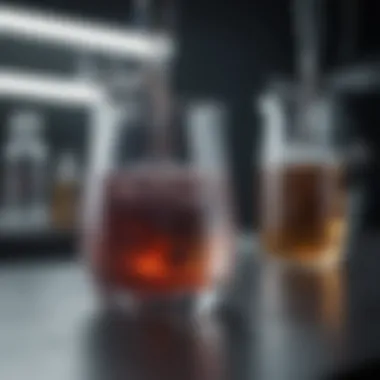In-Depth Analysis of Invitrogen SDS Applications


Intro
Invitrogen SDS, a crucial element in various scientific practices, finds its applications across a multitude of research areas. Understanding the precise functioning and characteristics of Invitrogen SDS is fundamental for researchers, educators, and students who engage with biochemistry and molecular biology. This section will initiate a serious exploration into its key properties and implications in experimental designs, aiming to clear away some of the complexities surrounding this important compound.
Methodologies
Description of Research Techniques
When examining Invitrogen SDS, several research techniques emerge as particularly relevant. One such method is electrophoresis, where SDS is extensively used to separate proteins based on their molecular weight. This technique reliably provides insights into protein characteristics, thus aiding in various applications ranging from basic research to clinical diagnostics.
Additionally, Western blotting is another technique that highlights the functionality of SDS. It not only allows for protein identification but also quantification, furthering its importance in diverse scientific investigations.
In biochemical assays, Invitrogen SDS serves multiple purposes including solubilization and denaturation of proteins, which are critical when preparing samples for quantitative analysis. Understanding these methods allows researchers to maximize the effectiveness of their experimental design while ensuring the integrity of their data.
Tools and Technologies Used
To effectively utilize Invitrogen SDS, specific tools and technologies are essential. Commonly used equipment includes:
- Gel electrophoresis apparatus: Facilitates the separation of proteins.
- Protein transfer system: Essential in Western blotting when proteins need to be transferred onto membranes for detection.
- Spectrophotometers: Help determine protein concentration before and after SDS treatment.
Understanding each of these tools ensures that researchers can confidently manipulate Invitrogen SDS for desired outcomes, further emphasizing the importance of proficiency in laboratory protocols.
Discussion
Comparison with Previous Research
The utilization of Invitrogen SDS has evolved through time. Past studies often relied on traditional methods, which lacked the precision offered by modern techniques. For example, earlier electrophoretic methods may have produced less reliable results when characterizing proteins. A comparative analysis shows that recent developments in SDS application significantly improve the quality of data gathered, reinforcing the compound's relevance.
A critical review of literature indicates that newer methodologies championed by Invitrogen SDS have yielded reproducible results that facilitate in-depth understanding of protein behaviors. This has opened avenues for more elaborate experimental designs and has led to discoveries that could not have been previously achieved.
Theoretical Implications
The impact of Invitrogen SDS extends beyond the lab. Theoretical implications of its use suggest a broader understanding of protein interactions and stability. This aligns with contemporary research goals, which aim to unravel complex biochemical pathways.
Moreover, embracing Invitrogen SDS encourages a re-examination of traditional theories regarding molecular interactions. Overall, the compound contributes meaningfully to discussions surrounding experimental integrity and data reliability, making it an indispensable asset in modern scientific inquiry.
"Invitrogen SDS stands as a landmark tool in progressive research methodologies, continually shaping our understanding of biochemistry."
Prelude to Invitrogen SDS
Invitrogen SDS is a significant subject in the field of scientific research. It serves as a powerful tool in various applications, especially in molecular biology. Understanding its role and characteristics is crucial for anyone involved in scientific explorations.
Sodium dodecyl sulfate (SDS) is an anionic detergent. It is widely used in laboratory practices. No matter whether you are a student, educator, or professional, knowing about SDS enhances your understanding of many experimental protocols.
The benefits of SDS are numerous. It can denature proteins, helping in analysis. Also, it promotes effective separation during gel electrophoresis. This way, researchers can obtain clearer results.
There are considerations as well. Handling SDS requires caution because of its chemical nature. Therefore, researchers must be aware of its properties and implications. This leads to better safety and accuracy in research outcomes.
Overall, introducing Invitrogen SDS sets the groundwork. It opens a dialogue about its pivotal role in advancing scientific inquiry. It prepares readers to delve deeper into its chemical properties and real-world applications.
Chemical Properties of Invitrogen SDS
Understanding the chemical properties of Invitrogen SDS is crucial for effectively utilizing this compound in various scientific applications. The molecular structure, solubility, and stability of SDS not only dictate its functionality but also influence other experimental outcomes. By exploring these properties, researchers can better grasp how Invitrogen SDS can be employed in their experiments and what implications it holds for reproducibility and reliability in research.
Molecular Structure
Sodium dodecyl sulfate (SDS) has a distinctive molecular structure that is essential for its role as an anionic surfactant. The molecule consists of a hydrophobic tail made up of a long carbon chain, typically containing twelve carbon atoms, and a hydrophilic head that carries a negatively charged sulfate group. This amphiphilic characteristic allows SDS to disrupt hydrophobic interactions in proteins, facilitating their denaturation. This quality is particularly relevant in procedures such as gel electrophoresis where separation of biomolecules is required.


The arrangement of atoms in SDS plays a pivotal role in its function as it can interact with both hydrophobic and hydrophilic environments. The active component in SDS promotes solubilization through micelle formation, essential for isolating proteins from complex mixtures or cell lysates.
Solubility Characteristics
SDS is widely known for its high solubility in water, which enhances its utility in various laboratory protocols. It readily dissolves at room temperature, even at high concentrations, making it a reliable component for buffer preparations. The ability of SDS to solubilize proteins is critical in applications where proteins are exposed to various conditions that might otherwise cause aggregation or precipitation. This solubilization is beneficial in assays where precise protein quantitation is required.
Moreover, SDS exhibits ionic behavior in solutions, further aiding in the dissociation of protein complexes. This soluble nature contributes significantly to challenges associated with purification and characterization of proteins, ensuring that even difficult-to-dissolve substances can be effectively analyzed.
Stability and Shelf Life
When considering the stability and shelf life of Invitrogen SDS, it is crucial to note its storage conditions and handling practices. SDS remains stable at room temperature but can hydrolyze under extreme conditions such as high temperatures or varying pH levels. Therefore, it is imperative to store SDS dry and away from light to maintain its effectiveness.
Typically, SDS solutions can last for several months if stored correctly. However, regular checks for precipitates or discoloration are advised, as these signs might indicate degradation. The stability of SDS has substantial implications for experimental consistency, thus necessitating strict adherence to recommended storage guidelines.
By paying careful attention to these properties, reliability and validity of experimental outcomes can be achieved, promoting integrity in research.
Applications of Invitrogen SDS
The applications of Invitrogen SDS stand as a fundamental aspect in understanding its significance within scientific research. The usefulness of SDS in various methodologies presents a reliable medium for elucidating many biochemical processes. The inherent qualities of SDS enable it to serve multiple critical functions, each of which contributes to advancing knowledge in diverse fields such as molecular biology and biochemistry.
Use in Gel Electrophoresis
SDS plays a pivotal role in the process of gel electrophoresis, a technique used to separate biomolecules, especially proteins, based on their size. The presence of SDS coats proteins with a negative charge, thereby ensuring that they migrate through a gel matrix in response to an electric field. This denaturing environment disrupts the native folds of proteins, and they unfold into linear chains, which allows for size-based separation. The effectiveness of SDS in gel electrophoresis is significant because it not only ensures consistent results but also enhances the resolution of the separated bands.
The choice of SDS concentration is essential in these experiments, as it can determine the extent of protein denaturation. Standard practices often employ a 0.1 to 0.5% solution of SDS in the running buffer. However, excessive amounts can lead to additional complications, such as compromising the protein's structural integrity too much. Understanding the dynamics of SDS concentration thus remains crucial in obtaining meaningful results when analyzing protein samples.
Role in Protein Denaturation
Invitrogen SDS’s capacity to denature proteins is fundamental in biochemical experimentation. The denaturation process is necessary before immunoblotting or similar assays because it ensures that proteins are in their unfolded state, exposing epitopes for antibody binding. This unfolding characteristic is vital for experiments where structural conformation is a variable of interest.
Moreover, the ability of SDS to disrupt disulfide bonds allows detailed analysis of protein subunits. Without SDS, it would be challenging to identify complex proteins' constituents, which often involve various interacting domains. Therefore, SDS serves both a practical and theoretical role in analyzing proteins, shaping how researchers develop hypotheses in proteomics.
Implications for Western Blotting
Western blotting, a widely adopted technique in molecular biology, relies heavily on SDS. In this process, proteins are separated using SDS-PAGE, transferred onto a membrane, and probed with specific antibodies. The quality of the antibodies’ interaction with the proteins is often dependent on successful denaturation, which SDS facilitates. A precisely executed Western blot can provide insights into protein expression levels, modifications, and interactions.
The implications of using SDS in Western blotting extend to quality control in research settings. Inconsistent SDS preparation or application can lead to misleading interpretations. Consequently, researchers place high importance on validating SDS concentration and buffer conditions each time they execute a Western blot.
"Understanding the role of SDS in experimental protocols not only unveils its functional mechanics but also underlines the necessity of proper technique in obtaining reliable scientific outcomes."
Protocol Considerations
Protocol considerations are essential when working with Invitrogen SDS, as they directly influence the outcome of experimental results. Understanding the specific guidelines helps in optimizing the use of SDS for various applications, thus enhancing the reliability and validity of scientific findings. Key aspects of protocol considerations include concentration guidelines, temperature and pH stability, and storage recommendations. Each of these elements plays a critical role in ensuring that researchers achieve consistent and reproducible results during their experiments.
Concentration Guidelines
Concentration guidelines are crucial when preparing solutions of SDS for laboratory experiments. The effective concentration not only affects the solubilization of proteins but also the efficacy in protein denaturation. Typically, SDS is used at concentrations ranging from 0.1% to 2.0%, depending on the specific application. For instance, in gel electrophoresis, around 0.1% to 0.5% is standard. Higher concentrations can lead to oversaturation, which can alter protein structure and hinder accurate analysis.
A careful approach to measurements is recommended. Using precise weights and volumetric flasks ensures accuracy in preparation. It is also wise to prepare working solutions freshly to maintain the integrity of SDS, as its properties can change over time, affecting experimental outcomes. Therefore, establishing clear concentration parameters according to established protocols is essential.
Temperature and pH Stability
SDS's stability is significantly influenced by temperature and pH levels. SDS can withstand a broad temperature range, but extremes can lead to degradation. The recommended temperature for use is typically between 20°C and 37°C. Working beyond this range may impair its effectiveness, leading to unpredictable results.
pH levels also play a critical role. SDS solutions should generally be maintained between pH 7 and 8 for optimal performance. Deviations can affect the charge properties of SDS, altering its interaction with proteins. Employing pH meters to regularly check the solution ensures that experiments remain in optimal conditions, providing more reliable and reproducible data.
Storage Recommendations


Proper storage of SDS is vital to maintain its functionality over time. SDS should be stored in a cool, dry place. Extended exposure to moisture can cause it to clump, which can affect the preparation of solutions. Ideally, it is recommended to keep SDS in tightly sealed containers to minimize exposure to air and humidity.
According to safety data sheets, SDS solutions should be stored away from direct sunlight and at room temperature, not exceeding 25°C. It is prudent to label containers with creation and expiration dates to ensure that only fresh solutions are used in experiments.
Important Advice: Always consult the manufacturer's guidelines for specific storage instructions concerning SDS to prevent degradation.
These protocol considerations are vital for anyone working with Invitrogen SDS. Through rigorous adherence to established guidelines and a keen understanding of the critical factors affecting SDS stability and performance, researchers can significantly enhance the quality of their scientific endeavors.
Safety and Handling
The topic of safety and handling is crucial when working with Invitrogen SDS, given its widespread applications in scientific research and potential hazards associated with its use. Understanding safety protocols helps uphold the integrity of scientific processes and ensures the well-being of researchers and students alike. This section covers the essential elements of safety practices, emphasizing the importance of adhering to guidelines for effective use of SDS in various applications.
Safety Data Sheets (SDS)
Safety Data Sheets (SDS) provide critical information about chemicals. They outline the properties, hazards, handling precautions, and emergency measures associated with the use of SDS. Every laboratory that uses Invitrogen SDS should maintain up-to-date Safety Data Sheets that are easily accessible to all personnel.
The following key points are typically included in an SDS for Invitrogen SDS:
- Identification: Details about the chemical, including product name and recommended uses.
- Hazard Identification: Information about potential hazards, such as irritation or toxicity risks.
- Composition/Information on Ingredients: Listing of the chemical components.
- First-Aid Measures: What to do in case of exposure.
- Fire-Fighting Measures: Recommended extinguishing media and firefighter precautions.
It is essential to familiarize oneself with these details. While SDS does not replace the need for personal vigilance, it serves as a foundational resource for implementing safe handling practices.
Personal Protective Equipment
Personal Protective Equipment (PPE) is a critical aspect of safety when handling Invitrogen SDS. Using appropriate PPE minimizes exposure risks and protects against chemical hazards. The specific PPE recommended includes:
- Gloves: Nitrile gloves provide a solid barrier against potential skin irritations and absorption.
- Safety Goggles: Protects the eyes from splashes during handling or mixing with other substances.
- Lab Coats: A disposable or reusable lab coat offers additional protection to skin and garments.
- Face Shields: Depending on the risk level, using face shields can provide extra protection during specific procedures.
Personnel should be trained on how to select and use these protective equipment. Regular inspections of PPE for damage or wear should also be a part of standard operating procedures.
Emergency Procedures
Emergency procedures related to Invitrogen SDS must be clearly defined and communicated in the laboratory setting. In the event of accidental exposure, spills, or fires, having a plan in place can be the difference between a minor incident and a serious crisis.
Key elements of emergency procedures include:
- Immediate First Aid: Guidelines on addressing skin or eye contact, inhalation, and ingestion.
- Spill Response: Step-by-step instructions for containing and cleaning spills safely.
- Fire Response: Details on the use of fire extinguishers and evacuation routes in case SDS catches fire.
- Incident Reporting: A system for documenting incidents to improve future safety practices.
Proper training on emergency procedures is essential. Regular drills help ensure preparedness in the face of unexpected situations.
Impact on Research Integrity
The integrity of scientific research is paramount, especially in fields that rely heavily on reproducibility and consistency. Invitrogen SDS plays a critical role in maintaining these standards. Its chemical properties and applications can significantly influence experimental results. When researchers choose a reagent, they consider not only its effectiveness but also how it maintains the integrity of their data.
Consistency and Reproducibility
Consistency refers to the ability to obtain the same results under unchanged conditions. In research, particularly in biochemical experiments, reproducibility is equally important. Invitrogen SDS serves as an essential tool in achieving these two goals. Its reliable formula ensures that results do not vary between different labs or experimental setups.
The use of SDS in protocols like gel electrophoresis exemplifies its impact. When employed properly, it allows for uniform separation of proteins, reducing variability. This consistency leads to reproducible outcomes, which are crucial for scientific validation. Researchers can trust that their findings are not influenced by discrepancies introduced by substandard reagents.
Moreover, ensuring that SDS concentrations are appropriate and consistent throughout experiments is vital. Variability in sodium dodecyl sulfate concentration can lead to erroneous results. Therefore, maintaining strict protocols around its use helps in achieving reproducible findings.
Potential for Contamination
While Invitrogen SDS is a powerful reagent, there exists a risk of contamination during its handling. Contaminated SDS can compromise experiments, leading to unreliable conclusions. It is essential to consider of the sources of contamination, which can include handling, storage, and the environment in which it is used.
Researchers need to follow strict safety and handling protocols to mitigate this risk. Utilizing personal protective equipment is critical to prevent contamination from skin or clothing. Additionally, proper storage in clean, labeled containers is necessary to avoid cross-contamination with other reagents.


"Even small amounts of contamination can lead to significant variations in protein analysis and other downstream applications."
Comparative Analysis with Other Detergents
Comparative analysis of detergents used in biological research is essential for understanding the best applications for different experimental protocols. Among the most commonly utilized detergents are Sodium Dodecyl Sulfate (SDS), Triton X-100, and NP-40. Each of these surfactants has unique properties that affect their function in various biochemical tasks.
When researchers select a detergent, they often consider factors like solubilization efficiency, ability to denature proteins, and compatibility with downstream applications. By examining these differences, scientists can make informed decisions that enhance the quality of their results. The following sections will provide a detailed comparison of SDS with Triton X-100 and NP-40, highlighting their specific uses and advantages.
SDS vs. Triton X-100
Sodium Dodecyl Sulfate and Triton X-100 are both popular detergents, but they serve different purposes in laboratory settings. SDS is an anionic detergent known for its strong protein denaturing capabilities. It disrupts the non-covalent bonds in proteins, crucial for tasks such as gel electrophoresis. Conversely, Triton X-100 is a non-ionic detergent, often used for solubilizing proteins while maintaining their functional integrity. Its milder impact on protein structure makes it suitable for applications that require the preservation of protein activity, such as immunoprecipitation or cell lysis where protein function must remain intact.
In terms of protein solubilization, SDS generally provides a better yield but at the cost of functionality. Researchers must carefully select which detergent best fits their experimental design and desired outcomes. In addition, Triton X-100 is less effective at denaturing DNA or RNA, making SDS a preferred choice in nucleic acid applications.
SDS vs. NP-40
N-Pentyl-4-hydroxybenzoate or NP-40, another non-ionic detergent, presents a different profile compared to both SDS and Triton X-100. Like Triton X-100, NP-40 is regarded for its gentle solubilization properties and is frequently used in studies involving membrane proteins and cellular components. However, it has a distinct advantage over Triton X-100 in terms of its ability to disrupt lipids without compromising protein structure significantly. This makes it particularly valuable in studies of lipid rafts or in scenarios where membrane integrity must be preserved.
While SDS excels in protein denaturation, NP-40 is favorable for experiments requiring solubilization of membrane proteins while maintaining their functionality. Researchers are advised to assess the type of proteins and membranes involved in their studies as SDS may lead to protein aggregation or loss of activity when used aggressively.
In summary, selecting the appropriate detergent, whether SDS, Triton X-100, or NP-40, is critical for experimental success. Each detergent has its merits, and the choice largely depends on the specific needs of the experiment and the characteristics of the biomolecules involved.
Conducting a thorough comparative analysis in these terms empowers researchers to optimize their methodologies, thereby reinforcing the integrity and reproducibility of their scientific findings.
Future Directions in SDS Research
The landscape of scientific research is always evolving. Thus, it becomes critical to focus not just on current methodologies but also on the possible advancements and adaptations in the use of Invitrogen SDS. This section aims to explore the future of SDS research and its potential contributions to the fields of biochemistry, molecular biology, and other related areas.
Innovations in Applications
The future holds promise for numerous innovations regarding the application of SDS. One notable trend is the enhanced use of SDS in combinatorial chemistry. By employing SDS in high-throughput screening, researchers can better analyze interactions between proteins and small molecules. This will expedite the drug discovery process significantly, making it more efficient and less time-consuming than traditional methods.
Additionally, advancements in microfluidics present new opportunities. Microfluidic devices can utilize SDS to facilitate the separation and analysis of biomolecules in smaller, controlled environments. This approach is smaller in scale but offers precision. Such devices can revolutionize diagnostic testing, making it faster and more accessible.
Moreover, research into optimizing SDS formulations is progressing. Scientists are exploring ways to modify the chemical structure of SDS to lower toxicity and environmental impact. This could lead to safer applications, especially in clinical and environmental settings, while retaining effectiveness in protein denaturation and solubilization.
Alternative Surfactants
As researchers continue to innovate, the exploration of alternative surfactants alongside SDS is gaining attention. Some alternatives may possess lower cytotoxicity or better biodegradability, addressing environmental concerns associated with traditional surfactants. For example, surfactants derived from natural sources, like rhamnolipids or sophorolipids, are being examined. These compounds tend to have less environmental impact and could be integrated into various applications where SDS is conventionally used.
In certain cases, these alternatives may provide unique properties not present in SDS. Their use could potentially lead to enhanced stabilization of proteins or greater specificity in biochemical assays. Each alternative surfactant comes with unique benefits and potential challenges, which requires careful evaluation.
"As researchers shift focus towards sustainable chemistry, alternative surfactants represent a pivotal point in ensuring that scientific advancements do not compromise ecological integrity."
Looking forward, the integration of alternative surfactants into research methodologies may progress to a level where they can stand as viable substitutes for SDS in specific cases. This transition could encourage a deeper understanding of how surfactants interact with proteins and other biological components.
Overall, the future directions of SDS research are diverse and hold significant potential. Each innovation and alternative points toward a comprehensive understanding of surfactants in scientific applications, thus enhancing the toolkit of researchers in their quest for discovery.
Epilogue
The concluding section of this article emphasizes the multifaceted role of Invitrogen SDS in contemporary scientific research. Understanding its properties, applications, and implications is essential for effective lab practices. SDS is not just a chemical; it is a pivotal component that influences the outcomes of various experiments.
Summary of Key Points
In summarizing the critical aspects of Invitrogen SDS, several key points emerge:
- Chemical Properties - The molecular structure, solubility, and stability metrics dictate its functionality in experimental designs.
- Applications - SDS lays the foundation for techniques like gel electrophoresis, protein denaturation, and western blotting.
- Protocol Considerations - Proper usage guidelines ensure reliable and repeatable results, preventing common pitfalls associated with concentration and temperature.
- Safety and Handling - Knowledge of safety data sheets and personal protective equipment is crucial for preventing workplace accidents.
- Research Integrity - Consistency and potential contamination issues highlight the importance of meticulous handling practices.
- Comparative Analysis - Understanding how SDS stacks up against other detergents is vital for selecting the appropriate agent for specific procedures.
- Future Directions - Innovations in SDS applications and the exploration of alternative surfactants suggest ongoing developments in this field.
The Importance of SDS in Scientific Research
SDS serves as a fundamental reagent in molecular biology and biochemistry. Its ability to denature proteins makes it indispensable in different analyses. Without SDS, the efficiency of protocols like western blotting would decrease significantly, impacting substantive research results.
Moreover, SDS supports reproducibility in scientific experiments, a key aspect of research integrity. Researchers must understand its advantages and limitations to maximize its potential effectively. Educators and students alike benefit from a thorough grasp of SDS, equipping them with necessary skills for experimental sciences.
"The essence of scientific inquiry is understanding how these elements interact to generate reproducible, reliable results. SDS plays a critical role in this equation."



